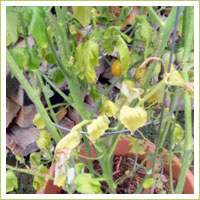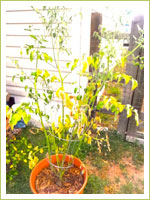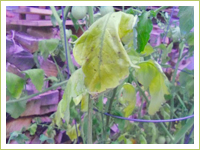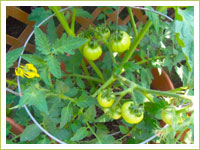
Call me a wimp if you want, but I’ve just emerged from the sick and twisted depths of tomato plant disease, and I literally feel faint. I really don’t know what it is about tomato plant disease that inspires a strong negative physical response in me. Past experience, maybe? Or perhaps the abundance of information using loaded descriptive terms like “infected” and “fungus” and “lesions”? Oh, gross.
And the images! Mama mia. Do yourself a favor: Don’t Google “bumps on tomato plant stems” unless you have a strong stomach and a high tolerance for the grotesque. (The more accurate term for bumps on tomato plant stems — which I’ve seen described as egg-like lumps near a stem burst, eesh — is “root initials,” and it happens when a plant’s vascular system is stressed ... here I go again. Keep it together, Erin … So the plant tries to sprout roots out of the stem, oh gag.)
 The reason for this torturous foray into the abyss? Several of my plants have shown evidence of … stress. Yeah, I can handle that.
The reason for this torturous foray into the abyss? Several of my plants have shown evidence of … stress. Yeah, I can handle that.
After a lot of research, and a significant number of smelling salts, I have a few leads about what’s going on. Although I’ve been diligent about not overwatering, we’ve had several torrential downpours lately. The excess of water has apparently 1) Distressed the plants, and 2) Created the perfect breeding ground for early blight.
As soon as I saw the word “blight” I experienced what I think is mild PTSD. Two seasons ago, in That Awful Year for tomato growers, I lost my entire (and first) crop to late blight. Adding insult to injury, I learned that tomatoes and potatoes are basically the same plant when it comes to blight — late blight is what caused the Irish potato famine that affected my ancestors so horrifically. What a slap in the face. It’s like the universe doing a big giant Neener Neener at me.

However, early blight is apparently fairly common and much more manageable. It is a symptom of warm temperatures and high humidity (check); the lower leaves turn yellow and drop (check); then higher foliage develops brownish spots before wilting and eventually dying (sigh, check).
Taking the advice of a dude online — who said early blight makes your tomato plant look “like the grim reaper took a crap on it,” thus lending him credibility in my eyes — I’ve pruned all the affected leaves and stems. I’ve also treated all the plants with a fungicide, hopefully preventing further damage.
 In the good news column, I can say that a couple of my grape tomatoes are starting to ripen! I am worried, though, because those plants seem the most affected by water stress.
In the good news column, I can say that a couple of my grape tomatoes are starting to ripen! I am worried, though, because those plants seem the most affected by water stress.
Also, does anyone know when the best time to pick tomatoes for the fried green purpose?